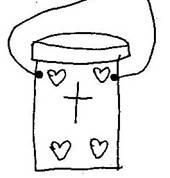Holy Unction
HOLY UNCTION
Objectives:
- Students should know the Scriptural basis for holy unction.
- Students should know the outline of the service and its meaning.
Possible Lesson Plan:
- Open with prayer.
- Scriptural basis: James 5:14-15, Luke 4:18, Matthew 10:5-9, Matthew 4:23, Acts 9:34, I Corinthians 12:9, John 14:12, Mark 2:1-12. Review some of the miracles of Christ: Can each student remember or find one in his Bible? Does God care about human suffering and illness?
- The order of the service:
|
Action |
Meaning |
|
1. Confession. |
The sick person must be healed in soul as well as in body. (See the story of the paralytic above.) |
|
2. Introductory prayers and psalms. |
We confess our sinfulness and ask God to create a new spirit within us. |
|
3. Canon. |
We ask God to have mercy on us, drive away all evil powers, and grant us healing so we may bless Him forever. |
|
4. Troparia to the Saints. |
We ask the saints, especially those who have suffered themselves as martyrs, and Mary to intercede for us. |
|
5. Epistle and Gospel lessons. |
Seven priests, seven epistles, and seven gospels – after each one the priest anoints the sick person with Holy Oil. |
|
6. Prayers of anointing. |
As the person is anointed, the priest reads a prayer asking for remission of the person’s sins and healing of his soul and body. |
- Discussion questions:
Can Jesus really heal the sick? Are there miracles today? Didn’t  Jesus have to touch the person to heal him? (No, remember the Roman centurion’s servant) Aren’t miracles really superstition? How does the sacrament of Holy Unction differ from say a rain dance by the pagans? Don’t we have doctors now we can go to if we are sick? Why doesn’t Jesus heal everyone? Why do we get sick at all? Aren’t we all going to die anyway? Should we only call for Holy Unction when we are dying? (no) In what other ways can we as Christians serve those who are ill, especially those who are chronically ill?
Jesus have to touch the person to heal him? (No, remember the Roman centurion’s servant) Aren’t miracles really superstition? How does the sacrament of Holy Unction differ from say a rain dance by the pagans? Don’t we have doctors now we can go to if we are sick? Why doesn’t Jesus heal everyone? Why do we get sick at all? Aren’t we all going to die anyway? Should we only call for Holy Unction when we are dying? (no) In what other ways can we as Christians serve those who are ill, especially those who are chronically ill?
- Make a “First Aid Kit” necklace: Begin with an empty pill bottle or film container. Fill with some items a child will recognize – band-aids, cotton ball, Alcohol prep – but be sure to include the phone number of the priest to remind them to call for prayer!
After filling, paint the container (or cover with contact paper), poke a hole through each side of the top just below the lid, and attach a string for wearing.
Alternate craft idea: Make a Healing Prayerbook – Print the front and back on cardstock or mount on construction paper and copy the pages and cut out. Children can write in the names of people they want to pray for. They can decorate with stickers. To bind simply twist a pipe cleaner around the top or use a staple or a brad.
6. Close with prayer.